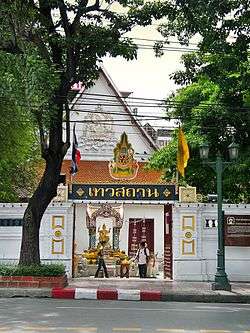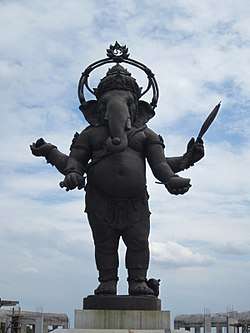Hinduism in Thailand
Hinduism is a minority religion in Thailand followed by 0.03% of its population.[1] Despite being a Bhuddist majority nation, Thailand has a very strong Hindu influence.The popular Thai epic Ramakien is based on the Ramayana.[2] The Emblem of Thailand depicted Garuda who is the vahana of Vishnu.[3]
History
.jpg)
A number of Hindus remain in Thailand. They are mostly located in the cities. In the past, the nation came under the influence of the Khmer Empire, which had strong Hindu roots. Despite the fact that today Thailand is a Buddhist majority nation, many elements of Thai culture and symbolism demonstrates Hindu influences and heritage. For example, the popular epic, Ramakien, is based on the Ramayana.[4] The Royal emblem of Thailand depicted Garuda, the vahana (vehicle) of Vishnu.[5]
The Thai city, Ayutthaya near Bangkok, is named after Ayodhya, the birthplace of Rama. Numerous rituals derived from Brahmanism are preserved in rituals, such as the use of holy strings and pouring of water from conch shells. Furthermore, Hindu deities are worshipped by many Thais alongside Buddhism, such as Brahma at the famous Erawan Shrine, and statues of Ganesh, Indra, and Shiva, as well as numerous symbols relating to Hindu deities are found, e.g., Garuda, a symbol of the monarchy. Reliefs in temple walls, such as the 12th-century Prasat Sikhoraphum near Surin (Thailand), show a dancing Shiva, with smaller images of Parvati, Vishnu, Brahma and Ganesha.[6]
The Devasathan is a Hindu temple established in 1784 by King Rama I. The temple is the centre of Brahminism in Thailand. The royal court Brahmins operate the temple, they perform several royal ceremonies per year.
_(6042345760).jpg)
An annual Giant Swing ceremony known as Triyampavai-Tripavai was held in major cities of Thailand until 1935, when it was abolished for safety reasons.[7] The name of the ceremony was derived from the names of two Tamil language Hindu chants: Thiruvempavai and Thiruppavai. It is known that Tamil verses from Thiruvempavai — poet pratu sivalai ("opening the portals of Shiva's home") — were recited at this ceremony, as well as the coronation ceremony of the Thai king.[8] According to T.P. Meenakshisundaram, the name of the festival indicates that Thiruppavai might have been recited as well.[9] The swinging ceremony depicted a legend about how the god created the world. Outside shops, particularly in towns and rural areas, statues of Nang Kwak as the deity of wealth, fortune and prosperity (version of Lakshmi) are found.[10][11]
The elite, and the royal household, often employ Brahmins to mark funerals and state ceremonies such as the Royal Ploughing Ceremony to ensure a good harvest. The importance of Hinduism cannot be denied, even though much of the rituals has been combined with Buddhism.[12]
According to the Thai Census of 2005, there are 52,631 Hindus living in Thailand, making up just 0.09% of the total population.[13]
Thai Brahmin community
.jpg)
Thailand has two ethnic Thai Brahmin communities-Brahm Luang (Royal Brahmins) and Brahm Chao Baan (folk Brahmins). The Brahm Luang(Royal Brahmins) mainly perform royal ceremonies of the Thai King. They belong to the long family bloodline of Brahmins in Thailand. The Brahm Chao Baan or folk Brahmins are the category of Brahmins who are not from a bloodline of priests. Generally, these Brahmins have a small knowledge about the rituals and ceremonies. The Devasathan is the centre of Brahmin activity in Thailand. It was built more than 200 years ago. Apart from this there are also Indian Brahmins from India who migrated to Thailand.[14]
Indian Hindus
During the Sukhothai and Ayutthaya periods, evidence of the presence of sizable number of Indians in the Thai court is described by a number of western travelers. However most of the contemporary Indians came to Thailand after 1920, and during the first half of the 19th century.[15]
The Mariamman Temple, Bangkok is the first temple built in the South Indian architecture.It was built in 1879 by Vaithi Padayatchi,a Tamil Hindu immigrant.[16][17][18]
Demographics
According to the 2010 Thailand census there are 41,808 Hindus in Thailand constituting 0.06% of the population.[19] In the 2015 census this population decreased to 22,110 or 0.03%.[20]
However the Pew research data found that Hinduism constituted 0.1% of the Thai population in 2014 and is also fastest growing religion in Thailand. The Pew research data reports that the Hindu population is expected to increase from 0.1% in 2014 to 0.2% by 2050[21]
Hindu sites in Thailand
 The front gate of the Devasathan built in 1784, the official center of Hinduism in Bangkok
The front gate of the Devasathan built in 1784, the official center of Hinduism in Bangkok The Lingam at Phanom Rung Historical Park in Buriram, showing remnants of the Khmer Empire in Thailand.
The Lingam at Phanom Rung Historical Park in Buriram, showing remnants of the Khmer Empire in Thailand. The Erawan Shrine in Pathum Wan, Bangkok is one of the most visited in the city.
The Erawan Shrine in Pathum Wan, Bangkok is one of the most visited in the city._2019_03.jpg) Mariamman Temple, Bangkok in Bangrak, Bangkok was built in 1879.
Mariamman Temple, Bangkok in Bangrak, Bangkok was built in 1879. San Phra Kan is a shrine dedicated to Vishnu in Lop Buri.
San Phra Kan is a shrine dedicated to Vishnu in Lop Buri. Bronze statue of Ganesha at the Khlong Khuean Ganesh International Park, Khlong Khuean, Chachoengsao.
Bronze statue of Ganesha at the Khlong Khuean Ganesh International Park, Khlong Khuean, Chachoengsao.
See also
| Wikimedia Commons has media related to Hinduism in Thailand. |
References
- "Population by religion, region and area, 2015" (PDF). NSO. Archived (PDF) from the original on 4 March 2020. Retrieved 12 October 2017.
- "Ramakien". Royal Thai Embassy.
- "The concept of Garuda in Thai society".
- "Ramakien". Royal Thai Embassy.
- "The concept of Garuda in Thai society".
- Sikhoraphum, Thailand, Arts & Archaeology Journal
- M. E. Manickavasagom Pillai (1986). Dravidian Influence in Thai Culture. Tamil University. p. 69.
- Upendra Thakur (1986). Some Aspects of Asian History and Culture. Abhinav. pp. 27–28. ISBN 978-81-7017-207-9.
- Norman Cutler (1979). Consider Our Vow: Translation of Tiruppāvai and Tiruvempāvai Into English. Muttu Patippakam. p. 13.
- Ara Wilson (2008), The Sacred Geography of Bangkok’s Markets, International Journal of Urban and Regional Research, Volume 32.3, September 2008, page 635
- Jonathan Lee, Fumitaka Matsuoka, Edmond Yee and Ronald Nakasone (2015), Asian American Religious Cultures, ABC, ISBN 978-1598843309, page 892
- "Hinduism Today | Thailand | July/August/September, 2003". Archived from the original on 30 October 2006. Retrieved 3 September 2006.
- http://popcensus.nso.go.th/show_table.php?t=t5&yr=2543&a=1
- "The new Brahmins". Retrieved 4 March 2020.
- "INDIAN COMMUNITY IN THAILAND". Retrieved 3 March 2020.
- Sandhu & Mani 2006, p. 978.
- Kesavapany & Mani 2008, p. 673.
- Manguin, Mani & Wade 2011, p. 475.
- "Population by religion, region and area, 2010" (PDF). NSO. Retrieved 2 March 2020.
- "Population by religion, region and area, 2015" (PDF). NSO. Retrieved 2 March 2020.
- "Hinduism fastest growing religion in Pakistan and Saudi Arabia". Retrieved 2 March 2020.

